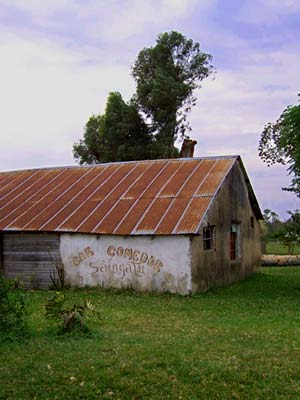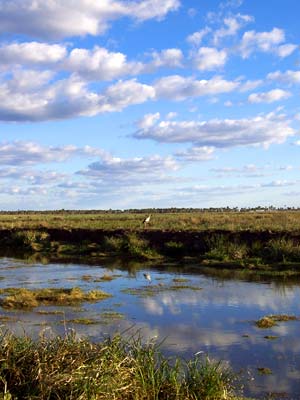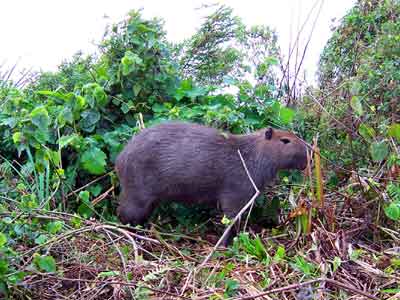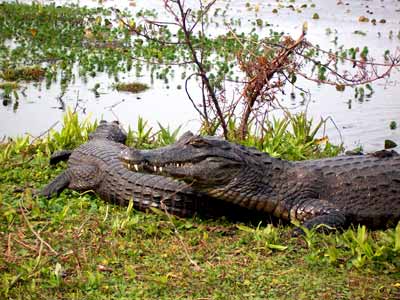Carpinchos & Caimans:
“Take Fletchabus #63 from Buenos Aires to Mercedes. A driver will meet you in Mercedes.” That was the extent of the correspondence I had received, and yet, like well-behaved sheep, Katie and I found ourselves at Buenos Aires’ Retiro bus station at 9pm, tickets in hand, ready to embark on what was supposed to be a ten-hour, 500-mile trip to the north.
During a trip where we routinely traveled completely on blind faith, our excursion to Los Esteros del Iberá in the heart of Argentina’s Corrientes Province required the biggest leap of all. Although, in the end, it produced the greatest rewards, as it led us to friendly folks, fascinating fauna, fabulous food, and flooded forests
Perhaps not surprisingly, even with the very comfortable semi-cama reclining seats of Flechabus #63, sleep did not come easily that night. Yet, despite our worst fears, almost exactly ten hours, seventeen stops, four movies, and two lomito (think shoe leather infused with the essence of beef) sandwiches later, at six o’clock the following morning, our bus arrived in the town of Mercedes.
From the two minutes of online research I had done on Mercedes, I figured it was a good-size city, and that it would have at least a decent-size bus station. To our surprise though, what Mercedes—which is home to 35,000 people—called a bus station, would scarcely register as a bus stop back in the States. Nonetheless, this is where the cryptic message told us to get off, and so once again, like cows willingly being led to the slaughter, we collected our bags and left the friendly confines of Fletchabus #63.
Six in the morning in northern Argentina in late July meant that the sun still had two hours to sleep, and our eyes were not prepared for the pitch-blackness in Mercedes. However, once our eyes adjusted, a sinking feeling began to set in. Fletchabus #63 had just slinked off into the abyss, and there we were with our far-too-large suitcases at the bus depot of Mercedes.
From the two minutes of online research I had done on Mercedes, I figured it was a good-size city, and that it would have at least a decent-size bus station. To our surprise though, what Mercedes—which is home to 35,000 people—called a bus station, would scarcely register as a bus stop back in the States. Nonetheless, this is where the cryptic message told us to get off, and so once again, like cows willingly being led to the slaughter, we collected our bags and left the friendly confines of Fletchabus #63.
Six in the morning in northern Argentina in late July meant that the sun still had two hours to sleep, and our eyes were not prepared for the pitch-blackness in Mercedes. However, once our eyes adjusted, a sinking feeling began to set in. Fletchabus #63 had just slinked off into the abyss, and there we were with our far-too-large suitcases at the bus depot of Mercedes.
A couple of minutes passed, and we noticed a small older man standing by a pick-up truck at the far end of the parking lot. Instinctively, we wandered toward him, and as we approached, he flashed a knowing grin and simply said, “Norman.” It was not a question but a statement that served as a reservation confirmation. Old Man & The Pick-Up
Old Man & The Pick-Up
Taking the path less traveled took on a whole new meaning as we stared out from the backseat of the old pick-up truck that was being driven by Julio, the man I assumed was our driver. Ahead was an unpaved, red dirt track that snaked its way off into the pre-dawn emptiness of Los Esteros. This was the only road, and we had been told it was over a two-hour drive to our final destination of Colonia Carlos Pellegrini. We had known this stranger for all of five minutes, but then the Fletchabus #63 had worked out, so why should we think twice about this?
By the time the sun finally rose around 7:45am, we were nearly forty miles into the Los Esteros del Iberá Provincial Park and we had seen only two other cars. At about that time, as we were finally able to see what the surrounding wilderness looked like, we were struck by the most dramatic feature of the landscape—that being the complete and total lack of any dramatic feature. It was perfectly flat grassland in all directions with only the occasional stand of imported eucalyptus or pine breaking the monotony.
La Laguna
Situated in the center of Los Esteros on the shores of la Laguna Iberá, Colonia Carlos Pellegrini is a small village of about 600 people, with sandy dirt roads, a couple of bars, and one phone which all the residents use to both make and receive calls. At one end of town, abutting la laguna, sits the splendid Posada Aguapé lodge. This rustically quaint hotel boasts lake access, a pool, delicious food, and one of the most caring and conscientious staff imaginable. In charge of the day-to-day operations at the Aguapé is a young fellow named Rafael, who along with his equally fun and energetic wife kept guests’ bellies full and smiles beaming at all times.
 Days at the Aguapé began with the sound of Rafael knocking on room doors informing guests that the boat would be leaving at 9am, and more importantly, that the hot tea and coffee, and the freshly baked rolls (and requisite dulce de leche) were ready in the dining room. Once roused, we made our way to the communal dining room and found ourselves at our room’s designated table eating alongside the Aguapé’s other guests. Since guests enjoy breakfast, lunch, teatime, and dinner together at the hotel, there were plenty of chances to mingle and get to know fellow Esteros adventurers. Entertainment was provided by the lodge’s resident bird population, which squawked and squabbled over the breadcrumbs and birdseed thrown on the lawn by the Aguapé staff. Awkwardly attractive giant wood-rails, strikingly blue Sayaca tanagers, and clown-like Monk parakeets made for a very motley but colorful cast of characters for the daily performances.
Days at the Aguapé began with the sound of Rafael knocking on room doors informing guests that the boat would be leaving at 9am, and more importantly, that the hot tea and coffee, and the freshly baked rolls (and requisite dulce de leche) were ready in the dining room. Once roused, we made our way to the communal dining room and found ourselves at our room’s designated table eating alongside the Aguapé’s other guests. Since guests enjoy breakfast, lunch, teatime, and dinner together at the hotel, there were plenty of chances to mingle and get to know fellow Esteros adventurers. Entertainment was provided by the lodge’s resident bird population, which squawked and squabbled over the breadcrumbs and birdseed thrown on the lawn by the Aguapé staff. Awkwardly attractive giant wood-rails, strikingly blue Sayaca tanagers, and clown-like Monk parakeets made for a very motley but colorful cast of characters for the daily performances.
Once breakfast was finished, the true Esteros experience began. Seated in a small boat driven by the Aguapé’s naturalist/handyman, Antonio, we sped across the lake, and instantly the place seemed to transform. We now became aware of the birds-of-prey soaring overhead and of the cormorants diving for fish, and we started to focus on the reedy islands that dotted the far end of the lagoon. As we neared the esteros (islands that are so waterlogged that they actually float), Antonio killed the outboard motor and began to pole us up a narrow channel. All of the boat’s passengers fell silent and edged off their seats, squinting at the banks in hopeful anticipation.
 Two minutes later, we were treated to the spectacle of a large, solitary, male carpincho—or capybara to the Brazilians to the north—all 100 pounds of overgrown guinea pig. He just sat there munching on river-weeds, acting like he could care less how close we got or how many shutter clicks we could fire in his direction. Not ten yards away, sunning himself on the opposite side of the reed-choked canal, sat the top predator of Los Esteros, a grinning, six-foot-long black caiman. This discovery brought excited giggles from the three young kids onboard our boat, while their parents—who up until that moment had allowed them to hang precariously over the side—quickly pulled them away from the bow and made them sit close by. This was the magic of Los Esteros, and it was not even 10am yet. The rest of the boat ride that first day, like those we took each morning, was filled with more of the same. Dozens of carpinchos and caimans lined the lagoon’s banks, while birds of every persuasion filled the sky, land, and water.
Two minutes later, we were treated to the spectacle of a large, solitary, male carpincho—or capybara to the Brazilians to the north—all 100 pounds of overgrown guinea pig. He just sat there munching on river-weeds, acting like he could care less how close we got or how many shutter clicks we could fire in his direction. Not ten yards away, sunning himself on the opposite side of the reed-choked canal, sat the top predator of Los Esteros, a grinning, six-foot-long black caiman. This discovery brought excited giggles from the three young kids onboard our boat, while their parents—who up until that moment had allowed them to hang precariously over the side—quickly pulled them away from the bow and made them sit close by. This was the magic of Los Esteros, and it was not even 10am yet. The rest of the boat ride that first day, like those we took each morning, was filled with more of the same. Dozens of carpinchos and caimans lined the lagoon’s banks, while birds of every persuasion filled the sky, land, and water.
Aguapé Afternoons
Afternoons at the Aguapé were far more relaxing than the mornings. Teatime at 4pm was the only officially scheduled event each day, and most guests dedicated a few hours to lounging in a hammock reading, or to taking advantage of a full siesta. In addition to taking daily naps, guests could choose to go on jungle hikes or boating trips, or take one of the Aguapé’s mountain bikes and explore Carlos Pellegrini on their own. During the course of our stay, Katie and I tried all of these activities, and each one was an experience.
Alejandro was a ranger in the park, and despite not having been paid in three months due to the Argentinean government’s economic woes, he was one of the most dedicated and passionate people we had ever met. He took us on two different excursions, and both times, he made us feel like he was sharing the park’s magic with a visitor for the very first time. One afternoon, after having been eaten alive by mosquitoes as we wandered through the scrubby jungle that bordered the lagoon, we were rewarded when Alejandro spotted a troop of Howler monkeys lazily feeding on leaves overhead. Katie and I shot half a roll of film each as we watched a baby Howler cling to its mother thirty feet above the forest floor, and though Alejandro had probably led dozens of tourists on this same hike, his enthusiasm and passion for showing off the park’s natural wonders was nothing short of inspirational.
 On another afternoon, after the clouds finally decided to give the earth a reprieve, and the rain stopped for the first time in 24 hours, Alejandro took Katie and me out on a canoe trip through some of the backwater channels that the bigger motorized boats could not navigate. Now, able to stealthily stalk herons and egrets, kingfishers and jacanas, and the ever-present caimans and carpinchos, it felt as though we were journeying into regions untouched by time or man’s influence.
On another afternoon, after the clouds finally decided to give the earth a reprieve, and the rain stopped for the first time in 24 hours, Alejandro took Katie and me out on a canoe trip through some of the backwater channels that the bigger motorized boats could not navigate. Now, able to stealthily stalk herons and egrets, kingfishers and jacanas, and the ever-present caimans and carpinchos, it felt as though we were journeying into regions untouched by time or man’s influence.
Our favorite excursion of all came during the afternoon of our last full day, when Rafael took us even deeper into Los Esteros on a bird-watching expedition. Being home to over 350 species of birds, Los Esteros is a birder’s paradise, and a place that even turned Katie into a “Life List” keeper. As a longtime avian aficionado, I was more than enthusiastic about the afternoon’s trip, and while the Aguapé’s other guests read or napped at the lodge, Rafael took us to some of the most spectacularly beautiful areas I had ever seen.
While he gleefully recounted the story of how he had had a crush on his wife from the time they were both fourteen and how he had eventually won her heart through sheer persistence and only after several unsuccessful attempts, Rafael pointed out dozens of the region’s birds. Able to not only spot, but also identify birds in mid-flight while driving a Land Rover over incredibly rough and worn roads, Rafael impressed and endeared himself to us. His stories about his childhood, his time in B.A., his wife, and of course, about the plants and animals that call Los Esteros home, were almost as colorful and entertaining as he was. During that afternoon’s trip, we saw flooded palm forests unlike anything I’d ever seen, hundreds of birds, and miles of unforgettable scenery. It was a perfect end to a perfect stay at the Aguapé.
What became clear for Katie and me that afternoon, as we bounced around in the Land Rover on the way back to the lodge for one last Aguapé dinner, was that Rafael and Alejandro and the entire Aguapé staff truly understood how precious and exquisite a place Los Esteros del Iberá was, and by the time we left the following morning, Katie and I had become true believers too.
